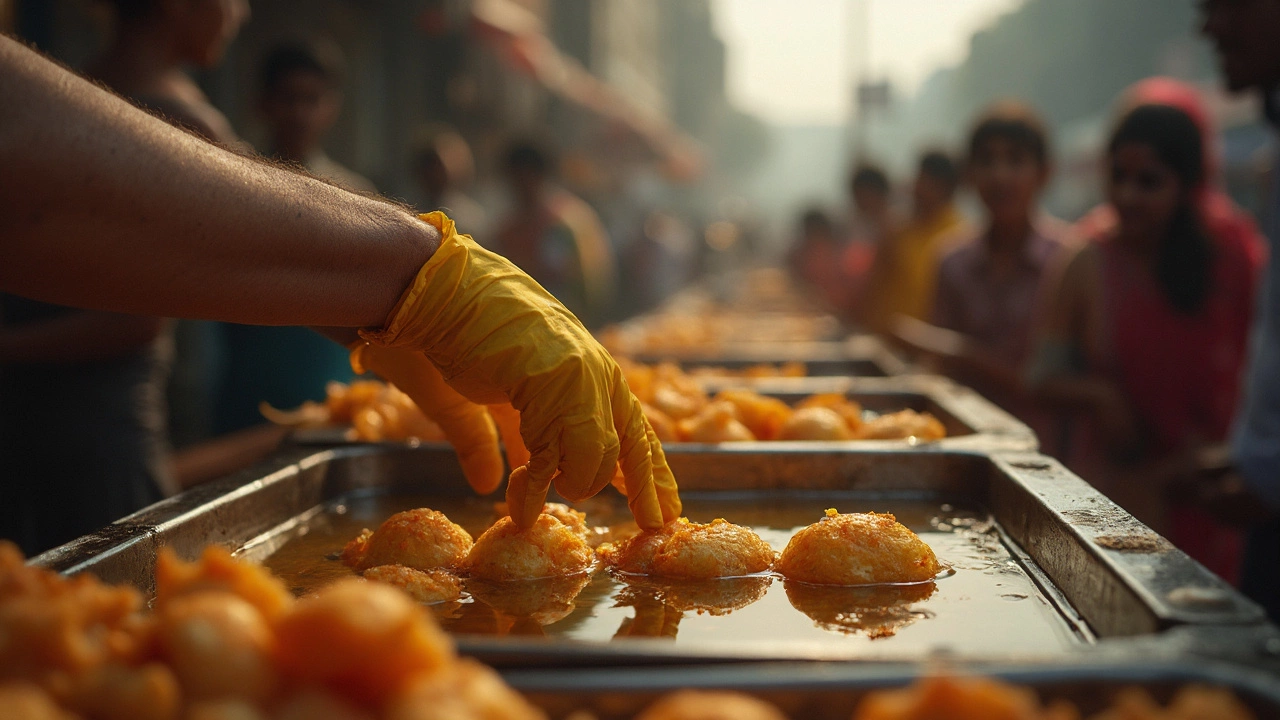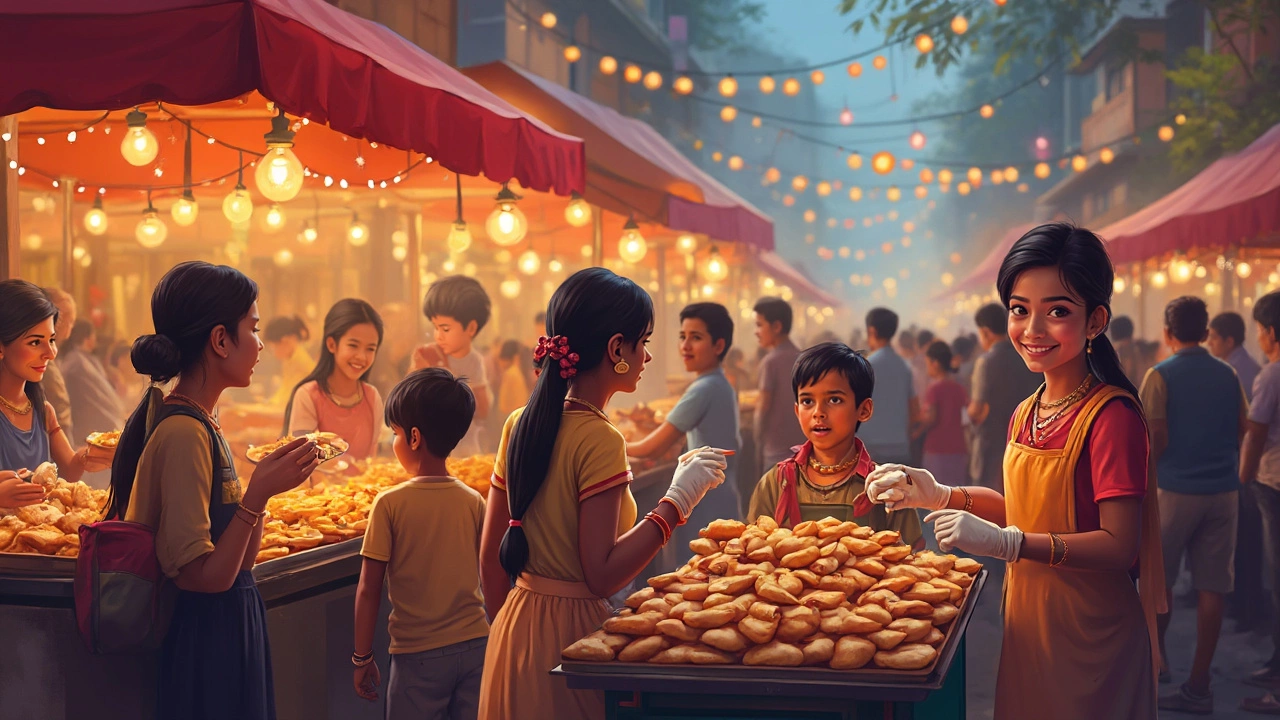When you think of India, vibrant markets and the aroma of spices drifting through the air often come to mind. Street food is a huge part of the local culture, offering a culinary adventure that's both diverse and exciting. But is it safe to eat? Well, let's dig into that.
First off, it's hard to deny the allure of street food. From crispy samosas to spicy chaats, each bite is an explosion of flavors. But as delicious as it is, the big question is about safety and hygiene. Anyone planning to indulge needs to be cautious.
You're probably wondering, how can one ensure they're not compromising their health? A simple rule of thumb is to observe the cleanliness of the stall and the vendor. This means paying attention to things like whether the cook is wearing gloves or if fresh ingredients are being used.
- Street Food Culture in India
- Common Hygiene Concerns
- Identifying Safe Street Food
- Tips for Eating Safely
- Popular Street Foods to Try
- Conclusion: Balancing Safety and Adventure
Street Food Culture in India
India's street food culture is a celebration of flavors and diversity, bringing together a medley of tastes that reflect the country's rich culinary heritage. Every region boasts its own specialties, each with a unique twist, making street food a canvas of India's regional diversity.
Street food isn’t just popular among locals; it's an essential part of the travel experience for anyone visiting. From the bustling lanes of Delhi's Chandni Chowk to Mumbai's Juhu Beach, exploring these stalls gives you a taste of authentic Indian cooking. Small carts line the streets, each with its loud sizzle and unique aroma, drawing in hungry crowds.
Popular Street Food Hubs
Some cities stand out as street food paradises. Kolkata's Park Street is famous for its Kathi Roll, a delicious paratha roll stuffed with assorted fillings. Meanwhile, Varanasi offers unique delights like Tamatar Chaat and the creamy Malaiyo, especially cherished in the winter.
In places like Lucknow, known for its nawabi or royal history, the Tunday Kababi sells melt-in-the-mouth kebabs that have become legendary. Similarly, the dosa stalls in Chennai serve these rice crepes alongside spicy chutneys and sambar, a must-try for any food enthusiast.
Beyond Just Food
But street food in India isn't just about eating; it's a social experience. Stalls aren’t just eateries; they're gathering spots where people from all walks of life come together, whether it's for a quick snack or a lively chat over piping hot chai.
Street food in India is also incredibly entrepreneurial, often family-run operations passed down through generations. Each vendor, with their secret spice mixes and flavors, plays a role in the city’s heartbeat. Their stalls may be modest, but the culinary experiences they offer are nothing short of remarkable.
In recent years, this beloved street food tradition has even made its way into fancy food festivals, showcasing its popularity and the pride Indians take in their street delicacies. This cultural expression is a vital part of India’s identity and a testament to its vibrant community spirit.
Common Hygiene Concerns
Eating street food in India is an experience unlike any other, but it comes with its own set of hygiene challenges. The open-air nature of the stalls can sometimes make them a target for dust and pests, which isn't ideal for food safety.
Water and Ingredient Quality
One of the main concerns is the quality of water used. Safe, potable water is crucial since it's used for everything from washing vegetables to making beverages. It’s a good idea to be wary of raw salads or any item that uses uncooked ingredients washed with potentially unsafe water.Vendor Cleanliness
Observing the hygiene of the vendor and their equipment is another critical factor. Are they using clean utensils? Is food being prepared freshly? These are the questions to keep in mind. A busy stall might indicate fresh turnover of ingredients, which is a positive signal.Storage Conditions
How food is stored and preserved is also important. Lack of proper refrigeration can lead to spoilage, especially pertinent in India’s hot climate. Seek out stalls with food kept under cover and away from flies and insects.Local Insight
Lastly, pay attention to what locals are eating. Often, they know the best spots that balance taste with safety. Joining a bustling queue could lead to a cleaner and safer eating experience.To sum it up, staying aware of these key hygiene factors can help you enjoy the delicious variety of India's street food safely.
Identifying Safe Street Food
Figuring out which street food is safe to eat can seem like a bit of a gamble, especially if you're new to Indian streets. But it doesn't have to be that way with a few handy tips under your belt.
Look for Busy Stalls
One of the easiest ways to spot safe street food is by checking the crowd. If a vendor has a long line of locals, that's usually a good sign. Popular stalls often mean fresh turnover, which translates to fresh ingredients and a better chance of maintaining cleanliness.
Check the Cleanliness
While it might sound obvious, cleanliness matters a lot. Observe the stall and the vendor’s habits. Are disposable gloves being used? Is the food being handled with utensils rather than bare hands? It’s also worth checking if waste is piling up around the stall, as this might attract pests.
Go for Cooked Food
Opt for food that's cooked in front of you. This reduces the risk of contamination. Look for items like vada pav or Kathi rolls, which are cooked fresh per order. Steer clear of anything that’s been left out for too long in the sun, such as pre-cut fruits and salads.
Use Your Senses
Let your senses guide you. If something smells off or looks a bit suspicious, give it a miss. Fresh, piping hot food usually smells great and is less likely to harbor germs.
Keep an Eye on Water Use
Always be cautious with anything that involves water, like juices or ice. Often, street vendors might not use filtered water, so it’s a safer bet to skip those coolers and juices.
| Street Food Type | Risk Level |
|---|---|
| Cooked Fresh (e.g., grilled kebabs) | Low |
| Raw or Pre-prepared (e.g., salads) | High |
Sticking to these guidelines can make your street food experience not just delicious but also safe. No one wants an unexpected conversation with the toilet on their travels, right?

Tips for Eating Safely
Diving into the world of street food in India is an adventure for your taste buds, but staying safe while doing it is crucial. Here are some tips to ensure you can munch away without a hitch.
Pay Attention to the Vendor
The cleanliness of a food stall can often reflect its food safety. Check if the vendor maintains basic hygiene, such as using gloves and tongs to handle food. It's also a good idea to see if fresh ingredients are on display instead of pre-cooked items sitting out.
Choose Well-Cooked Food
Opt for food that's cooked right in front of you. High temperatures can kill off most germs. So if you see something bubbling away in hot oil, it's generally a safer bet.
Follow the Crowd
A busy food stall is often a good sign. It means fast turnover, and the food is less likely to be sitting out, collecting germs. Plus, locals usually know the best spots, so following the crowd isn't a bad idea.
Drink Wisely
It's best to avoid drinks with ice, as the water source is sometimes questionable. Bottled drinks or freshly squeezed juices, prepared in front of you, are safer options.
Use Hand Sanitizer
Keep hand sanitizer handy. Clean hands before and after you eat to reduce the risk of any unwanted bacteria making its way in along with that delicious food.
Exploring Indian street food can be one of the highlights of your travels, but keeping these tips in mind will help ensure the experience is both tasty and safe.
Popular Street Foods to Try
India's street food scene is a bustling affair, and if you're visiting, there are some must-try street foods that capture the essence of its diverse culinary landscape.
Chaat
One of the most famous and iconic street foods is chaat. This spicy, tangy snack originates from northern India but has fans all over the country. Crispy puris, boiled potatoes, chickpeas topped with yogurt, and tamarind chutney make a delightful mix. It's a must-try, especially in Delhi and Mumbai.
Pav Bhaji
Pav Bhaji is not just food; it's an experience. A spicy mix of veggies mashed together and served with buttery bread rolls. Originally from Mumbai, it's now found across India. It's best enjoyed at bustling markets where you can see it being freshly made before your eyes.
Pani Puri
This is a snack that's as much about the skill of the vendor as it is about the taste. Pani puri, or golgappa as it's known in some places, involves hollow, crispy shells filled on the spot with flavored water, chickpeas, and tamarind. Just watching it being prepared is an experience.
Vada Pav
Think of this as an Indian version of a burger. Vada pav consists of a spicy, deep-fried potato patty in a bread bun, served with chutneys. It's a flavorsome snack, best tried in the streets of Mumbai where it originated.
Samosas
No list is complete without samosas. These are fried or baked pastries with savory fillings, like spiced potatoes or lentils. They're a popular snack all over India and perfect for when you need a quick bite on the go.
Data on Street Food Preferences
| Street Food | Popularity Rank |
|---|---|
| Pani Puri | 1 |
| Samosas | 2 |
| Pav Bhaji | 3 |
| Chaat | 4 |
| Vada Pav | 5 |
Wherever you find yourself in India, these street foods promise a tasty, authentic experience. Just remember, cleanliness first and stay adventurous!
Conclusion: Balancing Safety and Adventure
Diving into the world of street food in India presents an exciting challenge. There's a truth to it being both an adventure and a cultural immersion, but it's essential to be mindful of safety as well. The key is finding that sweet spot where taste meets trust.
Many travelers and locals agree that some of the most authentic flavors are found right on the bustling streets. After all, street food is an integral part of India's food heritage. But, like any worthwhile adventure, it's not without its risks.
The Safe Adventure
So, how do you enjoy the exquisite taste of street food while staying safe? First, follow the locals. They're often clued into which stalls are both popular and reliable. Trust your instincts at all times; if a stall doesn't look clean, give it a pass.
Here's a checklist to keep in mind when scoping out street food:
- Observe the stall's hygiene practices. Does the vendor use clean water?
- Look at how the food is stored and served. Is it out in the open or covered wisely?
- Follow the crowds. Busy stalls usually mean fresher food.
Expert Insight
According to a food safety officer in Mumbai, "A little awareness and alertness can offer a street food experience that's both delightful and safe." It's about making informed choices without missing out on the experience altogether.
"The vibrant food markets are the heart of our cities. With some precautions, tourists can savor delicious meals with minimal worry," – Food Safety Expert, Aman Kapoor.
Ultimately, the charm of Indian street food lies in its diversity and flavor. Balancing safety with adventure is entirely possible. Just prioritize a little precaution, and you'll be on your way to indulging in some unforgettable culinary delights.
